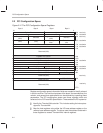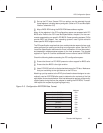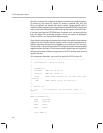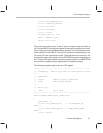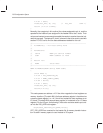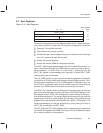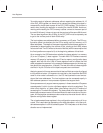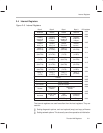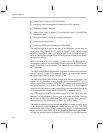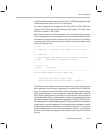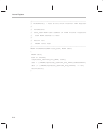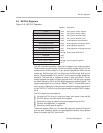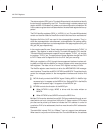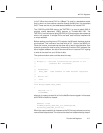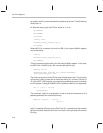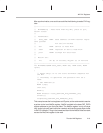
Internal Registers
2-12
Setting commit levels and PCI burst levels
Interfacing via the management interface to the PHY registers
Determining status interrupts
Setting eight bytes of default PCI configuration data if the EEPROM
checksum is bad
Setting the various unicast and multicast addresses
Providing network statistics
Setting the LEDs and implementing a BIOS ROM
The NetCmd
register is used to set many of the diagnostic modes such as
wrap, copy short frames (CSF), copy all frames (CAF), no broadcast
(NOBRX), duplex, and token ring frame formats. It also includes a reset bit,
which is used to allow changes in the NetConfig
register for additional network
configuration options.
NetSio, the network serial I/O register
,
is used to control the MDIO/MDCLK
management interface. It is also used to communicate with an EEPROM, us-
ing the EDIO/EDCLK serial interface. This register can also enable or disable
PHY interrupts.
The
NetSts and NetMask registers work in tandem to determine the nature of
a status interrupt. The bits in the NetMask register are used to mask whether
the status flags in NetSts cause interrupts or not.
The
NetConfig register sets network configuration options during reset. This
register can only be written to when ThunderLAN is in reset (NRESET = 0). It
allows the controller to receive CRCs (RxCRC), pass errored frames (PEF),
use a one-fragment list on receive (refer to subsection 5.3, One-Fragment
Mode, for more information), use a single transmit channel, enable the internal
PHY, and select the network protocol (CSMA/CD or demand priority).
The AREG registers allow ThunderLAN to recognize any four 48-bit IEEE 802
address. This includes specific, group, local, or universal addresses. They can
be Ethernet or token ring addresses. The HASH registers allow group ad-
dressed frames to be accepted on the basis of a hashing table.
The statistics registers hold the appropriate network counters, including good
Tx and Rx frames, collisions, deferred frames, and error counters. The LEDs
are controlled through the
LEDreg
register, which directly controls the values
output on the LED lines EAD[7::0]. All are, therefore, software programmable.
LEDreg can also be used to implement a BIOS ROM. The
Acommit register



